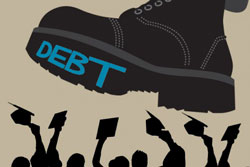According to a recent report by Experian, the national student loan debt has reached $1.2 trillion, the highest it has ever been. Additionally, the analysis concluded that a total of 40 million people across the country are grappling with student loans.
After the recession, most forms of consumer debt began to decrease, however, student loans have increased by 84 percent and show no signs of slowing down.
Thirty-nine percent ($417 billion) of all student loans are in a deferment period, or the time when a student is not immediately required to make a payment. The other 61 percent ($727 billion) of the loans are classified under the repayment period in which borrowers are required to pay back loans in a timely fashion.
Despite their distressing effects, loans have the potential to positively contribute to an individual’s future. So long as payments are continuously made, the individual’s credit score will continue to rise. According to the report, the average credit score of adults who are repaying loans is 640, which is 20 points higher than the average.
John Burke, a specialist professor of finance, said that a number of factors contribute to the drastic increase in student debt. “One reason for the dramatic growth in student loans has been the rapid increase in college tuition rates,” he said. “Over the last three decades, college tuition rates have increased at about double the rate of inflation. The rate has been even steeper over the past two decades, 10.3% or almost three times the rate of inflation.”
“Another factor has been the ever increasing percentage of students using student loans,” continued Burke. According to the specialist professor, this has increased from 45 percent to 70 percent over the past two decades.
Burke added that while the percent of students using student loans has doubled over the past two decades, the average student loan balance upon graduation has more than tripled.
According to the National Center for Education Statistics Data, the average debt per student has reached its highest cost in history at more than $30 thousand dollars per borrower.
 One of the main problems students encounter when taking loans is that they are often deceived by loan providers.
One of the main problems students encounter when taking loans is that they are often deceived by loan providers.
Anthony Branco, a recent graduate of Monmouth University’s Business School, said that he has already been noticing his peers struggle with loan difficulties. “I know too many people that are being negatively impacted by student loans,” said Branco. “They agree to false promises stating that their loans will be paid off in a shortened period of time, but in reality they are paying higher interest rates and getting fooled over.”
The deceptiveness of loan providers has not gone unnoticed by the government. In March, President Barack Obama signed the “Student Aid Bill of Rights,” which plans to assist students in the repayment of their college loans. Obama suggests that one website needs to be created on which students can access their loan and repayment information. Further, another website needs to be created on which the borrowers can file complaints about loan providers. Therefore, there will be no confusion or disagreements as to when a repayment is to be made.
Although some potential college students may be deterred by the crippling debt, Patrick L. O’Halloran, an associate professor of economics, said he believes that a college education is still incredibly valuable. “Most empirical evidence reveals that higher education remains a worthwhile investment which more than pays for itself in higher future earnings among those with a college degree. Moreover, given the media attention given to the issue of student debt burdens, I’d expect that there will be more focus on potential payoffs of obtaining various degrees from different schools,” said O’Halloran.
“There have been several governmental policy proposals to mandate that institutions of higher learning publish comparable statistics showing such things as placement rates, completion rates, and more,” explained O’Halloran.
O’Halloran added that he expects to see more focus on the financial return to various degrees and less focus on the non-pecuniary aspects of a college education.
Moreover, perhaps the most unfortunate dilemma occurs if a student drops out of college before attaining his/her degree. Then, the student will still be required to pay off the loans but will likely not have the proper means to do so.
Burke noted that students need to understand the gravitas of debt; it is a financial obligation that is a direct consequence of an education. If they do not follow their obligations, their future opportunities will be hampered as a result of poor credit. This will affect their chances of taking a loan for an automobile, home, or other luxury.
O’Halloran added that the answer to the student loan conundrum may lie in the functionality of the workforce.
“I think the solution partly depends on how our labor markets treat new graduates. If we have a healthy labor market with good paying jobs available to new grads, the debts should not prove to be too burdensome,” said O’Halloran. “However, if our labor markets offer few ‘good’ jobs for graduates, the debt accumulated over time as students defer payments and accumulate more debt may cause many to doubt the value of their college degree. Of course, how we foster the creation of good jobs is another issue. One could argue that a more educated society would generate more good jobs than a less educated society, so it becomes an issue of the chicken or the egg.”
IMAGE TAKEN from trcfwpa.com
IMAGE TAKEN from popularresistance.org


